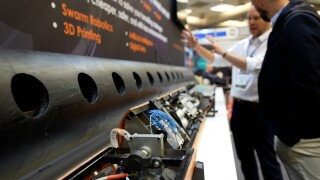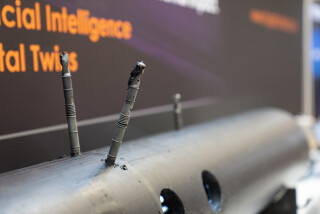At the British Tunnelling Society (BTS) conference and exhibition in London last week, a company called HyperTunnel, unveiled a proprietary robotic delivery system that it claims to be “revolutionary infraTech for tunnels”.
HyperTunnel representatives demonstrated how little robot devices could transport cartridges of construction chemicals through horizontal directional drilling (HDD) bore pipes to 3D-print a tunnel in the ground.
It is claimed that this modular approach could be scaled up to make tunnel building, repair, enlargement and monitoring, faster, cheaper and safer.
HyperTunnel is based in Basingstoke and was set up in 2018 by entrepreneurs Steve Jordan and Jeremy Hammond, neither of whom appears to have any engineering credentials or tunnelling experience. Jeremy Hammond’s background is in selling beer and tobacco, initially in his native South Africa, and later in property in the UK.
They have assembled a team of engineers and managers with diverse backgrounds. Director of engineering Patrick Lane-Nott is an automotive engineer who has worked in Formula One. Director of operations Patrick Simpson has a degree in catering management and previously ran a company making steel flue liners, according to his LinkedIn profile.

The concept, which is currently under advanced testing at various sites in the UK, is to ‘build’ the tunnel digitally first and then send robots into the ground to get to work. Using a series of bore pipes as an outline for the tunnel, they 3D-print the tunnel inside the ground.

The semi-autonomous robots move throughout the inside of the bores to create the structural shell of the tunnel using swarming techniques. After the geology within the shell is disrupted, spoil is removed with a remote-controlled excavation shield. A continuous concrete layer can then be sprayed onto the shell and the construction completed, if required, with custom linings. Secondary bore pipes are used to house monitoring technologies which improve long-term tunnel maintenance and safety.

HyperTunnel has a research & development contract with Network Rail, which it secured after bringing in Mark Carne, former Network Rail chief executive, as chairman.
Mark Carne said: “The advantages of HyperTunnel’s form of underground construction are clear to see: nobody goes underground until the tunnel is built, so it is far safer, and because the process is much faster than traditional methods, there is much lower cost. Asset owners will surely be attracted to the long term ability HyperTunnel provides, to be able to precisely monitor the behaviour of the whole tunnel over time.”

Co-chief executive, co-founder and co-owner Steve Jordan said: “We have been overwhelmed by the interest and support in the HyperTunnel approach from within the tunnelling and underground construction industry, and I genuinely hope we have convinced new friends to join a long overdue new movement within tunnelling, globally.”
Got a story? Email news@theconstructionindex.co.uk



